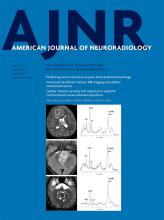Index by author
Verny, C.
- Adult BrainYou have accessGJA1 Variants Cause Spastic Paraplegia Associated with Cerebral HypomyelinationL. Saint-Val, T. Courtin, P. Charles, C. Verny, M. Catala, R. Schiffmann, O. Boespflug-Tanguy and F. MochelAmerican Journal of Neuroradiology May 2019, 40 (5) 788-791; DOI: https://doi.org/10.3174/ajnr.A6036
Vooturi, S.
- FELLOWS' JOURNAL CLUBPediatricsYou have accessFocal Cortical Dysplasia and Refractory Epilepsy: Role of Multimodality Imaging and Outcome of SurgeryS. Jayalakshmi, S.K. Nanda, S. Vooturi, R. Vadapalli, P. Sudhakar, S. Madigubba and M. PanigrahiAmerican Journal of Neuroradiology May 2019, 40 (5) 892-898; DOI: https://doi.org/10.3174/ajnr.A6041
The authors performed a retrospective analysis of data from 188 consecutive patients with focal cortical dysplasia and refractory epilepsy with at least 2 years of postsurgery follow-up. Predictors of seizure freedom and the sensitivity of neuroimaging modalities were analyzed. MR imaging showed clear-cut FCD in 136 (72.3%) patients. Interictal FDG-PET showed focal hypo-/hypermetabolism in 144 (76.6%); in 110 patients in whom ictal SPECT was performed, focal hyperperfusion was noted in 77 (70.3%). Focal resection was the most common surgery performed in 112 (59.6%) patients. Histopathology revealed type I FCD in 102 (54.3%) patients. At last follow-up, 124 (66.0%) were seizure-free. Complete resection of FCD and type II FCD were predictors of seizure freedom. Localization of FCD on either MR imaging or PET or ictal SPECT had the highest sensitivity for seizure freedom at 97.5%. They conclude that during presurgical multimodality evaluation, localization of the extent of the epileptogenic zone in at least 2 imaging modalities helps achieve seizure freedom in about two-thirds of patients with refractory epilepsy due to FCD. FDG-PET is the most sensitive imaging modality for seizure freedom, especially in patients with type I FCD.
Vossough, A.
- LetterYou have accessUse of Balanced Steady-State Free Precession Sequences in Evaluation of Drop MetastasesA. Vossough and E.R. MelhemAmerican Journal of Neuroradiology May 2019, 40 (5) E20; DOI: https://doi.org/10.3174/ajnr.A5964
Wiesmann, M.
- Adult BrainYou have accessIncreased Water Content in Periventricular Caps in Patients without Acute HydrocephalusT. Sichtermann, J.K. Furtmann, S. Dekeyzer, G. Gilmour, A.M. Oros-Peusquens, J.P. Bach, M. Wiesmann, N.J. Shah and O. NikoubashmanAmerican Journal of Neuroradiology May 2019, 40 (5) 784-787; DOI: https://doi.org/10.3174/ajnr.A6033
Wolf, N.I.
- PediatricsYou have accessOculodentodigital Dysplasia: A Hypomyelinating Leukodystrophy with a Characteristic MRI Pattern of Brain Stem InvolvementI. Harting, S. Karch, U. Moog, A. Seitz, P.J.W. Pouwels and N.I. WolfAmerican Journal of Neuroradiology May 2019, 40 (5) 903-907; DOI: https://doi.org/10.3174/ajnr.A6051
Wright, A.G.
- Head & NeckOpen AccessReduced Jet Velocity in Venous Flow after CSF Drainage: Assessing Hemodynamic Causes of Pulsatile TinnitusH. Haraldsson, J.R. Leach, E.I. Kao, A.G. Wright, S.G. Ammanuel, R.S. Khangura, M.K. Ballweber, C.T. Chin, V.N. Shah, K. Meisel, D.A. Saloner and M.R. AmansAmerican Journal of Neuroradiology May 2019, 40 (5) 849-854; DOI: https://doi.org/10.3174/ajnr.A6043
Wu, C.-Y.
- SpineYou have accessAssessing Vascularity of Osseous Spinal Metastases with Dual-Energy CT-DSA: A Pilot Study Compared with Catheter AngiographyY.-C. Huang, F.-Y. Tsuang, C.-W. Lee, C.-Y. Wu and Y.-H. LinAmerican Journal of Neuroradiology May 2019, 40 (5) 920-925; DOI: https://doi.org/10.3174/ajnr.A6023
Yamamoto, M.
- EDITOR'S CHOICENeurointerventionYou have accessUsefulness of Silent MR Angiography for Intracranial Aneurysms Treated with a Flow-Diverter DeviceH. Oishi, T. Fujii, M. Suzuki, N. Takano, K. Teranishi, K. Yatomi, T. Kitamura, M. Yamamoto, S. Aoki and H. AraiAmerican Journal of Neuroradiology May 2019, 40 (5) 808-814; DOI: https://doi.org/10.3174/ajnr.A6047
Silent MRA is a procedure using an ultrashort TE and arterial spin-labeling techniques, which efficiently visualizes the status after the treatment of intracranial aneurysms. In Silent MRA, the 3D image is reconstructed by subtracting the control image from the image obtained by the labeling pulse. Seventy-eight large, unruptured internal carotid aneurysms in 78 patients were the subjects of this study. After 6 months of treatment, they underwent follow-up digital subtraction angiography, Silent MRA, and TOF-MRA, performed simultaneously. The authors found Silent MRA is superior for visualizing blood flow images inside flow-diverter devices compared with TOF-MRA. Furthermore, Silent MRA enables the assessment of aneurysmal embolization status. Silent MRA is useful for assessing the status of large and giant unruptured internal carotid aneurysms after flow-diverter placement.
Yamashita, K.
- FELLOWS' JOURNAL CLUBPediatricsOpen AccessIntravoxel Incoherent Motion MR Imaging of Pediatric Intracranial Tumors: Correlation with Histology and Diagnostic UtilityK. Kikuchi, A. Hiwatashi, O. Togao, K. Yamashita, R. Kamei, D. Momosaka, N. Hata, K. Iihara, S.O. Suzuki, T. Iwaki and H. HondaAmerican Journal of Neuroradiology May 2019, 40 (5) 878-884; DOI: https://doi.org/10.3174/ajnr.A6052
Between April 2013 and September 2015, seventeen children with intracranial tumors were included in this retrospective study. Intravoxel incoherent motion parameters were fitted using 13 b-values for a biexponential model. The perfusion-free diffusion coefficient, pseudodiffusion coefficient, and perfusion fraction were measured in high- and low-grade tumors. The authors found significant correlations between the histology and IVIM parameters of different pediatric intracranial tumors. These results suggest that IVIM imaging reflects cell density and vascularity across different types of pediatric brain tumors. They also demonstrated that both the diffusion and perfusion parameters measured on IVIM imaging are useful for grading intracranial neuroectodermal tumors in pediatric patients.
Yatomi, K.
- EDITOR'S CHOICENeurointerventionYou have accessUsefulness of Silent MR Angiography for Intracranial Aneurysms Treated with a Flow-Diverter DeviceH. Oishi, T. Fujii, M. Suzuki, N. Takano, K. Teranishi, K. Yatomi, T. Kitamura, M. Yamamoto, S. Aoki and H. AraiAmerican Journal of Neuroradiology May 2019, 40 (5) 808-814; DOI: https://doi.org/10.3174/ajnr.A6047
Silent MRA is a procedure using an ultrashort TE and arterial spin-labeling techniques, which efficiently visualizes the status after the treatment of intracranial aneurysms. In Silent MRA, the 3D image is reconstructed by subtracting the control image from the image obtained by the labeling pulse. Seventy-eight large, unruptured internal carotid aneurysms in 78 patients were the subjects of this study. After 6 months of treatment, they underwent follow-up digital subtraction angiography, Silent MRA, and TOF-MRA, performed simultaneously. The authors found Silent MRA is superior for visualizing blood flow images inside flow-diverter devices compared with TOF-MRA. Furthermore, Silent MRA enables the assessment of aneurysmal embolization status. Silent MRA is useful for assessing the status of large and giant unruptured internal carotid aneurysms after flow-diverter placement.








